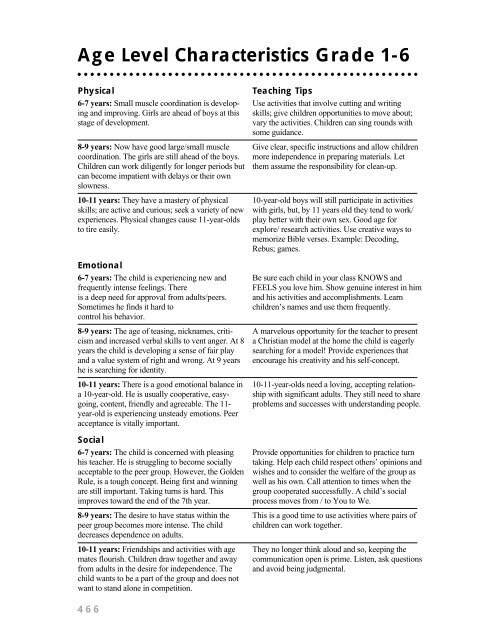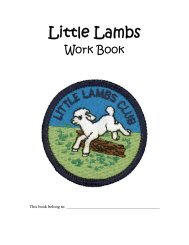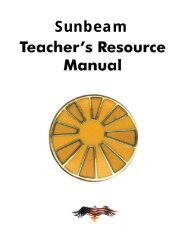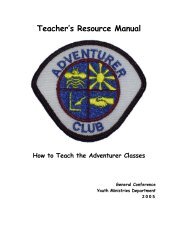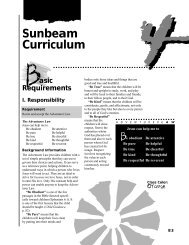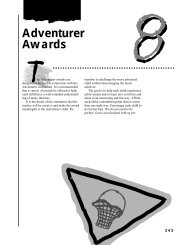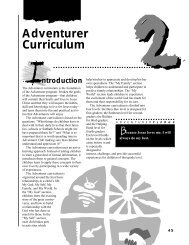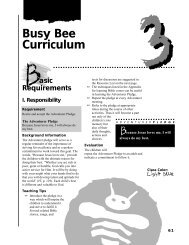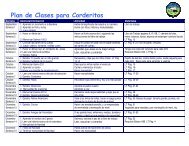Age Level Characteristics Grade 1-6 - KFW Adventurers
Age Level Characteristics Grade 1-6 - KFW Adventurers
Age Level Characteristics Grade 1-6 - KFW Adventurers
Create successful ePaper yourself
Turn your PDF publications into a flip-book with our unique Google optimized e-Paper software.
<strong>Age</strong> <strong>Level</strong> <strong>Characteristics</strong> <strong>Grade</strong> 1-6<br />
○ ○ ○ ○ ○ ○ ○ ○ ○ ○ ○ ○ ○ ○ ○ ○ ○ ○ ○ ○ ○ ○ ○ ○ ○ ○ ○ ○ ○ ○ ○ ○ ○ ○ ○ ○ ○ ○ ○ ○ ○ ○ ○ ○ ○ ○ ○ ○ ○ ○ ○ ○ ○<br />
Physical<br />
6-7 years: Small muscle coordination is developing<br />
and improving. Girls are ahead of boys at this<br />
stage of development.<br />
8-9 years: Now have good large/small muscle<br />
coordination. The girls are still ahead of the boys.<br />
Children can work diligently for longer periods but<br />
can become impatient with delays or their own<br />
slowness.<br />
10-11 years: They have a mastery of physical<br />
skills; are active and curious; seek a variety of new<br />
experiences. Physical changes cause 11-year-olds<br />
to tire easily.<br />
Emotional<br />
6-7 years: The child is experiencing new and<br />
frequently intense feelings. There<br />
is a deep need for approval from adults/peers.<br />
Sometimes he finds it hard to<br />
control his behavior.<br />
8-9 years: The age of teasing, nicknames, criticism<br />
and increased verbal skills to vent anger. At 8<br />
years the child is developing a sense of fair play<br />
and a value system of right and wrong. At 9 years<br />
he is searching for identity.<br />
10-11 years: There is a good emotional balance in<br />
a 10-year-old. He is usually cooperative, easygoing,<br />
content, friendly and agreeable. The 11-<br />
year-old is experiencing unsteady emotions. Peer<br />
acceptance is vitally important.<br />
Social<br />
6-7 years: The child is concerned with pleasing<br />
his teacher. He is struggling to become socially<br />
acceptable to the peer group. However, the Golden<br />
Rule, is a tough concept. Being first and winning<br />
are still important. Taking turns is hard. This<br />
improves toward the end of the 7th year.<br />
8-9 years: The desire to have status within the<br />
peer group becomes more intense. The child<br />
decreases dependence on adults.<br />
10-11 years: Friendships and activities with age<br />
mates flourish. Children draw together and away<br />
from adults in the desire for independence. The<br />
child wants to be a part of the group and does not<br />
want to stand alone in competition.<br />
Teaching Tips<br />
Use activities that involve cutting and writing<br />
skills; give children opportunities to move about;<br />
vary the activities. Children can sing rounds with<br />
some guidance.<br />
Give clear, specific instructions and allow children<br />
more independence in preparing materials. Let<br />
them assume the responsibility for clean-up.<br />
10-year-old boys will still participate in activities<br />
with girls, but, by 11 years old they tend to work/<br />
play better with their own sex. Good age for<br />
explore/ research activities. Use creative ways to<br />
memorize Bible verses. Example: Decoding,<br />
Rebus; games.<br />
Be sure each child in your class KNOWS and<br />
FEELS you love him. Show genuine interest in him<br />
and his activities and accomplishments. Learn<br />
children’s names and use them frequently.<br />
A marvelous opportunity for the teacher to present<br />
a Christian model at the home the child is eagerly<br />
searching for a model! Provide experiences that<br />
encourage his creativity and his self-concept.<br />
10-11-year-olds need a loving, accepting relationship<br />
with significant adults. They still need to share<br />
problems and successes with understanding people.<br />
Provide opportunities for children to practice turn<br />
taking. Help each child respect others’ opinions and<br />
wishes and to consider the welfare of the group as<br />
well as his own. Call attention to times when the<br />
group cooperated successfully. A child’s social<br />
process moves from / to You to We.<br />
This is a good time to use activities where pairs of<br />
children can work together.<br />
They no longer think aloud and so, keeping the<br />
communication open is prime. Listen, ask questions<br />
and avoid being judgmental.<br />
466
Intellectual<br />
6-7 years: There is an intense eagerness to learn<br />
and they ask lots of questions. The child likes to<br />
repeat stories/activities. There is a limited concept<br />
of time…thinking is here and now rather than past<br />
or future. Listening/speaking skills are developing<br />
rapidly. Girls are ahead of boys. The child thinks<br />
everyone shares his view. He sees parts rather<br />
than how the parts make up the whole. He thinks<br />
very literally.<br />
8-9 years: The child is beginning to realize there<br />
may be other valid opinions. He is becoming a<br />
reasoning person; beginning to think in terms of<br />
“the whole”; he thinks more conceptually and has<br />
a high level of creativity.<br />
10-11 years: They are verbal! Making ethical<br />
decisions becomes a challenging task. They are<br />
able to express ideas and feelings in a creative<br />
way. At 11 years the child begins to reason<br />
abstractly. He begins to think of himself as an<br />
adult and questions adult concepts. Hero worship<br />
is strong.<br />
Spiritual<br />
6-7 years: The child can sense the greatness,<br />
wonder and love of God when helped with visual<br />
and specific examples. The non-physical nature of<br />
God is teaming, but, omnipresence is generally<br />
accepted because parents and teachers communicate<br />
this belief by their attitudes and actions. The<br />
child can think of Jesus as his friend, but needs<br />
specific examples of how Jesus expresses love<br />
and care. He can comprehend talking to God<br />
anywhere, anytime in his own word, and he needs<br />
regular opportunities to pray. He can also know<br />
that the Old Testament tells what happened before<br />
Jesus was born and the New Testament tells of<br />
His birth, work on earth and return to heaven and<br />
the works that occurred afterwards on earth.<br />
8-9 years: He is beginning to sense the need for<br />
God’s continuous help and guidance. He can<br />
recognize the need for a personal Savior. There is<br />
a desire to become a member of God’s family.<br />
Children who indicate an awareness of sin and<br />
concerned about accepting Jesus as Savior, need<br />
careful guidance without pressure.<br />
10-11 years: They can have deep feelings of love<br />
for God; can share the “Good News” with a<br />
special friend and are capable of involvement in<br />
evangelism and service projects. The child may<br />
seek guidance from God to make everyday and<br />
long-range decisions.<br />
Teaching Tips<br />
Consider the skill/ability levels of the children.<br />
Some can handle reading/writing activities and<br />
others may do better with music or art. Use pictures<br />
to help them understand Bible times and people.<br />
Avoid symbolism!<br />
Encourage them to look up information: discover<br />
their own answers to problems, use art, music, and<br />
drama. Help children learn Bible information and<br />
concepts. Allow them to use their Bibles by finding<br />
and reading portions. Bible reading games are good<br />
for this age and these are good years for Bible<br />
memory work. Help children understand the<br />
meaning of the verses they memorize.<br />
Include lots of opportunities for talking, questioning<br />
and discussing. These are good years for<br />
poetry, songs, drama, stories, drawing and painting.<br />
Give guidance in a way that does not destroy the<br />
child’s efforts in becoming a thinking, self-directed<br />
person.<br />
The gospel becomes real as the child feels love<br />
from adults. Teachers who demonstrate their faith<br />
in a consistent, loving way may become channels<br />
through which the loving nature of God can be<br />
made known to a child.<br />
Help children develop a feeling for communication<br />
with God through prayer.<br />
Help them understand the forgiving nature of God.<br />
Provide opportunities to make choices and decisions<br />
based on Bible concepts.<br />
Provide opportunities for children to participate in<br />
prayer, Bible reading and worship. Involve them in<br />
work and service projects.<br />
Taken from Creative Bible Learning for<br />
Children, © copyright 1977 by Regal Books,<br />
a division of Gospel Light Publications.,<br />
Ventura, CA 93006.<br />
467
About Six<br />
Physical Development<br />
Growth proceeding more slowly, and lengthening<br />
out.<br />
Large muscles better developed than small ones.<br />
Eleven to twelve hours of sleep needed.<br />
Eyes not yet mature. Tendency toward farsightedness.<br />
Permanent teeth beginning to appear.<br />
Heart in period of rapid growth.<br />
High activity level-can stay still only for short<br />
periods.<br />
<strong>Characteristics</strong> Behavior<br />
Eager to learn, exuberant, restless, overactive,<br />
easily fatigued.<br />
Self-assertive, aggressive, wants to be first, less<br />
cooperative, than at five, keenly competitive,<br />
boastful.<br />
Whole body involved in whatever he does.<br />
Learns best through active participation.<br />
Inconsistent in level of maturity evidencedregresses<br />
when tired, often less mature at<br />
home than with outsiders.<br />
Inept at activities using small muscles.<br />
Relatively short periods of interest.<br />
Has difficulty making decisions.<br />
Group activities popular, boys’ and girls’<br />
interests beginning to differ.<br />
Much spontaneous dramatization.<br />
Special Needs<br />
Encouragement, ample praise, warmth, and<br />
great patience from adults.<br />
Ample opportunity for activity of many kinds,<br />
especially for use of large muscles.<br />
Wise supervision with minimum interference.<br />
Friends-by end of period, a best friend.<br />
Concrete learning situations and active, direct<br />
participation.<br />
Some responsibilities, but without pressure and<br />
without being<br />
required to make<br />
complicated<br />
decisions or achieve<br />
rigidly set standards.<br />
Help in developing<br />
acceptable manners<br />
and habits.<br />
About Seven<br />
Physical Development<br />
Growth slow and steady<br />
Annual expected growth in height-two or three<br />
inches. In weight- three to six pounds.<br />
Losing teeth. Most seven-year-olds have their<br />
six-year molars.<br />
Better eye- hand coordination.<br />
Better use of small muscles.<br />
Eyes not yet ready for much close work.<br />
<strong>Characteristics</strong> Behavior<br />
Sensitive to feelings and attitudes of both other<br />
children and adults. Especially dependent<br />
on approval of adult.<br />
Interest of boys and girls diverging. Less play<br />
together.<br />
Full of energy but easily tired, restless and<br />
fidgety, often dreamy and absorbed.<br />
Little abstract thinking. Learns best in concrete<br />
terms and when he can be active while<br />
learning.<br />
Cautious and self-critical, anxious to do thing<br />
well likes to use hands.<br />
Talkative, prone to exaggerate, may fight<br />
verbally instead of physically, competitive.<br />
Enjoys songs rhythms, fairy tales, myths, nature<br />
stories, comics, television, movies.<br />
Able to assure some responsibility.<br />
Concerned about right and wrong, but often<br />
prone to take small things.<br />
Rudimentary understanding of time and monetary<br />
values.<br />
Special Needs<br />
The right combination of independence and<br />
encouraging support.<br />
Chances for active participation in learning<br />
situations with concrete objects.<br />
Adult help in adjusting to the rougher ways of<br />
the playground without becoming<br />
too crude or rough.<br />
Warm, encouraging,<br />
friendly relationships<br />
with adults.<br />
Acceptance at own level<br />
of development.<br />
468
About Eight<br />
Physical Development<br />
Growth still slow and steady-arms lengthening,<br />
hands growing<br />
Eyes ready for both near and far vision. Nearsightedness<br />
may develop this year.<br />
Permanent teeth continuing to appear.<br />
Large muscles still developing. Small muscles<br />
better developed, too. Manipulative skills<br />
are increasing.<br />
Attention span getting longer.<br />
Poor posture may develop.<br />
Characteristic Behavior<br />
Often careless, noisy, argumentative, but also<br />
alert, friendly, interested in people.<br />
More dependent on his mother again, less so on<br />
his teacher. Sensitive to criticism.<br />
New awareness of individual differences.<br />
Eager, more enthusiastic than cautious. Higher<br />
accident rate.<br />
Gangs beginning. Best friends of same sex.<br />
Allegiance to other children instead of to an<br />
adult in case of conflict.<br />
Greater capacity for self-evaluation.<br />
Much spontaneous dramatization, ready for<br />
simple classroom dramatics.<br />
Understanding of time and of use of money.<br />
Responsive to group activities. Both spontaneous<br />
and adult-supervised.<br />
Fond of team games, comics, television,<br />
movies, adventure stories, collections.<br />
Special Needs<br />
Praise and encouragement from adults<br />
Reminders of his responsibilities.<br />
Wise guidance and channeling of his interests<br />
and enthusiasms rather than domination or<br />
unreasonable standards.<br />
A best friend.<br />
Experience of belonging to peer group—<br />
opportunity to identify with others of<br />
same age and sex.<br />
Adult-supervised groups and planned after<br />
school activities.<br />
Exercise of both large and small muscles.<br />
About Nine or Ten<br />
Physical Development<br />
Slow, steady growth continues-girls forge<br />
further ahead. Some children reach the<br />
plateau preceding the preadolescent<br />
growth spurt.<br />
Lungs as well as digestive and circulatory<br />
systems almost mature. Heart especially<br />
subject to strain.<br />
Teeth may need straightening. First and second<br />
bicuspids appearing.<br />
Eye-hand coordination good. Ready for crafts<br />
and shop work.<br />
Eyes almost adult size. Ready for close work<br />
with less strain.<br />
Characteristic Behavior<br />
Decisive, responsible, dependable, reasonable,<br />
strong sense of right and wrong.<br />
Individual differences distinct, abilities now<br />
apparent.<br />
Capable of prolonged interest. Often makes<br />
plans and goes ahead on his own.<br />
Gangs strong and of one sex only, of short<br />
duration and changing membership.<br />
Perfectionist—wants to do well, but loses<br />
interest if discouraged or pressured.<br />
Interested less in fairy tales and fantasy, more in<br />
his community and country and in other<br />
countries and peoples.<br />
Loyal to his country and proud of it.<br />
Spends a great deal of time in talk and discussion.<br />
Often outspoken and critical of<br />
adults, although still dependent on adult<br />
approval.<br />
Frequently argues over fairness in games.<br />
Wide discrepancies in reading ability.<br />
Special needs<br />
Active rough and tumble play.<br />
Friends and membership in a group.<br />
Training in skills, but without pressure.<br />
Books of many kinds, depending on individual<br />
reading level and interest.<br />
Reasonable. Explanations without talking down.<br />
Definite responsibility.<br />
Frank answers to questions about coming<br />
physiological changes.<br />
469


